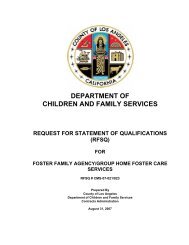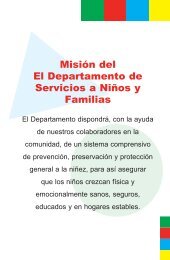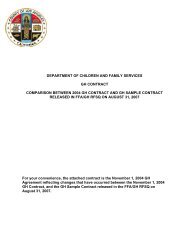Permanency Guide - Los Angeles County Department of Children ...
Permanency Guide - Los Angeles County Department of Children ...
Permanency Guide - Los Angeles County Department of Children ...
Create successful ePaper yourself
Turn your PDF publications into a flip-book with our unique Google optimized e-Paper software.
INTRODUCTION<br />
Foster care was designed to be temporary. Its purpose was to provide care for<br />
children living in unsafe and dangerous situations, while supportive services were<br />
<strong>of</strong>fered to their families toward the goal <strong>of</strong> reunification. However, hundreds <strong>of</strong><br />
thousands <strong>of</strong> children and youth find themselves growing up in foster care, without<br />
permanent families or any lifelong connections.<br />
Some children living in foster care have changed homes multiple times and many<br />
remain in the foster care system until they reach age <strong>of</strong> majority and “age out” <strong>of</strong> the<br />
system. In essence, many children are being raised in foster care. Many <strong>of</strong> these<br />
children have attended a variety <strong>of</strong> schools and received a spotty education. These<br />
same youth may not have a consistent group <strong>of</strong> friends or family, and have lost<br />
contact with those important to them. They lack permanence in their lives.<br />
Research tells us that every year in<br />
California, approximately 4,000 children<br />
leave foster care with no permanent family<br />
connection. These youth “age out” <strong>of</strong> foster<br />
care without a family to support them in their transition to adulthood. Without the<br />
social, emotional, and financial support typically <strong>of</strong>fered to youth by their families,<br />
many former foster youth find themselves alone during this important period in<br />
their lives. Many youth face several serious challenges. Unable to overcome<br />
these challenges on their own, these youth have become over-represented in the<br />
populations <strong>of</strong> youth who are homeless. A disproportionate number <strong>of</strong> former<br />
foster youth become incarcerated, face early pregnancy, are poorly educated, and<br />
lack skills for employment.<br />
The fundamental role <strong>of</strong> foster care is being re-examined in order to improve<br />
outcomes for children and families involved in the child welfare system. All children are entitled to permanency, and the<br />
child welfare system is obligated to ensure this. <strong>Los</strong> <strong>Angeles</strong> <strong>County</strong> has expanded our vision and definition <strong>of</strong><br />
permanency for our youth. We are striving to provide all children with a legally permanent plan <strong>of</strong> reunification, adoption or<br />
legal guardianship. Additionally, we have made a commitment to work toward the goal that no child leaves foster care<br />
without a lifelong connection to a caring adult.<br />
For youth that are not able to return home to their parents’ care, every effort must be made to identify adults to provide<br />
permanence for them so they do not grow up in foster care. If returning home is not possible, then a permanent<br />
connection must be identified to support the youth throughout their life upon “aging out” <strong>of</strong> the system.<br />
3
















